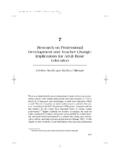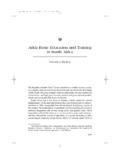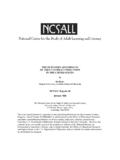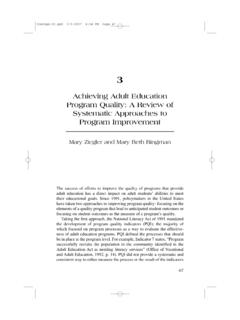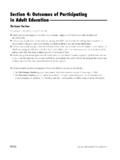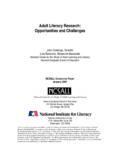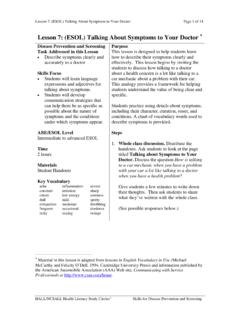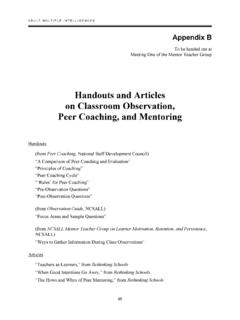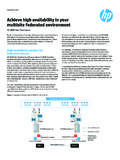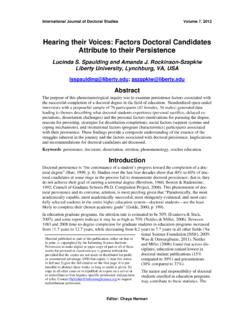Transcription of Persistence: Helping Adult Education Students …
1 232 persistence : Helping AdultEducation Students ReachTheir GoalsJohn P. ComingsUnlike children, who participate in schooling because of legal mandatesand strong social and cultural forces, most Adult Students choose to par-ticipate in educational programs. adults must make an active decision toparticipate in each class or tutoring session and often must overcome sig-nificant barriers to participate in educational services. Although someadults come to Adult education10programs with specific or short-termgoals, most come with goals that require hundreds, if not thousands, ofhours of instruction to achieve (Comings, Parrella, & Soricone, 1999;Reder, 2000).
2 Every Adult Education program, therefore, should provideits Students with services that help them persist in learning long enough toreach their educational goals. This chapter defines persistence , sets out theevidence for why we should pay attention to this issue, and reviews the10 The term Adult educationincludes English for speakers of other language, Adult liter-acy, high school equivalence, and basic skills programs for 2/2/2007 5:57 PM Page 23persistence research. The chapter concludes by suggesting changes inpolicy and practice that might support higher levels of persistence , andnew research that would provide evidence that these suggestions OF PERSISTENCEP ersistencecan be seen as being comprised of two parts: intensity (thehours of instruction per month) and duration (the months of engagementin instruction).
3 persistence rates are reported as hours of instruction dur-ing a specific period of months, usually in increments of 1 year. Adulteducation programs often refer to persistence as retention11and measureit by recording participation in formal classes or tutoring sessions. Comingsand colleagues (1999) proposed the term persistence because adults canpersist in learning through self-study or distance Education when they stopattending program services, and sometimes return to a program (althoughnot necessarily the same one they dropped out of) after a lapse in atten-dance.
4 The term retention defines this phenomenon from a program spoint of view; the program wants to retain its Students . Comings and col-leagues (1999) preferred the term persistence because it defines this phe-nomenon from the point of view of Students who persist in learning insideand outside of a program until they have achieved their goals. This chapterdefines Persistence: As adults staying in programs for as long as they can, engaging in self-directedstudy or distance Education when they must stop attending program services,and returning to program services as soon as the demands of their lives is a continuous learning process that lasts until an Adult stu-dent meets his or her educational goals.
5 And persistence could startthrough self-study before the first episode of participation in a ends when the student decides to stop persistence MATTERSThe relationship between persistence and learning is supported by severalstudies. Sticht (1982) and Darkenwald (1986) identified approximately24 COMINGS11 Keeping Students engaged in a particular 2/2/2007 5:57 PM Page 24100 hours of instruction as the minimum needed by adults to achieve anincrease of one grade-level equivalent on a standardized test of readingcomprehension.
6 Comings, Sum, and Uvin (2000) found that, at 150 hoursof instruction, Adult Students in Massachusetts had a 75% probability ofmaking a one (or greater) grade-level equivalent increase in reading com-prehension or English language fluency. Porter, Cuban, and Comings(2005) found that 58 hours of instruction led to a .40 grade-level equiva-lent increase in reading comprehension. Rose and Wright (2006) exam-ined the national reporting system (NRS) data of three states and foundthat at 100 to 110 hours of participation, 50% of Students were likely toshow a one NRS level12increase or pass the general equivalency diploma(GED) and Young (1997) analyzed data on the 614 Students (out of22,000) in a Development Associates (1993) study who had both a pretestand a posttest reading score.
7 They found a relationship between hours ofinstruction and learning gains for immigrants learning English, but not foradult basic Education (ABE) and Adult secondary Education (ASE) Students . With a sample of less than 1% of the total Students in the study,these results are not conclusive. However, it suggests, as do the studiescited earlier, that Adult Students might demonstrate gains at specific inter-vals, 100 hours for example, but the interval may differ depending on suchfactors as initial test studies point to 100 hours of instruction as the point at which amajority of Adult Education Students are likely to show measurableprogress, and, therefore, it serves as a benchmark that identifies an effec-tive program.
8 That is, if a majority of Students are persisting for 100 hoursor more, the program is probably having a measurable impact on at leasthalf of its Students . The Department of Education (2003) reportedthe average time that an Adult spends in a program as 113 hours13in a12-month period. However, this figure does not include adults who dropout before they complete 12 hours of instruction, which would lower Students REACH THEIR GOALS2512A one NRS level increase represents an improvement in a score on a standardized testfrom one defined level to another.
9 Each NRS level is a range of approximately two grade-level equivalents so an increase could be as little as a single scale score point (a small seg-ment of a grade-level equivalent) to two grade-level equivalents. 13134 hours for adults learning English, 103 hours for adults who are improving theirliteracy and math skills, and 87 hours for adults pursuing a high school equivalency. 2/2/2007 5:57 PM Page 25average significantly. In addition, these data were influenced by one state(Florida) that reported a mean persistence rate of 258 hours and enroll-ment at more than 400,000 Students , which is more than 15% of thenational total.
10 Only three other states reported a mean persistence rate ofmore than 100 hours: California (138 hours), Massachusetts (121 hours),and North Carolina (102 hours). Seven states reported an average persis-tence rate of less than 50 hours, and 36 states reported less than 80 large portion of the student population who stay at least 12 hours do notpersist in their studies for 100 113 hours of instruction is only about one tenth of the time that aK 12 student spends in class during a year. A one grade-level increase,therefore, is a significant gain within this short period of time.
